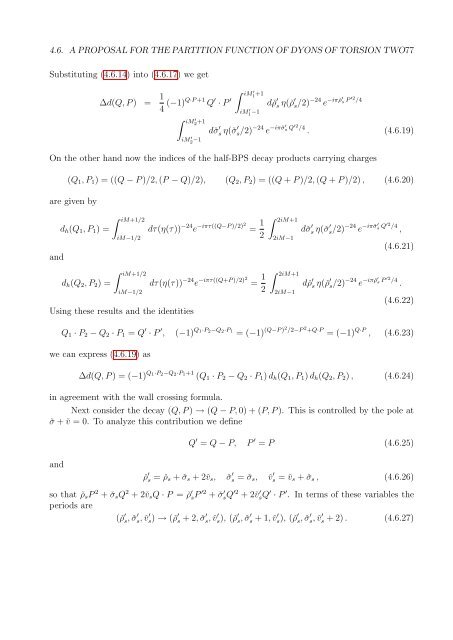PHYS08200604018 Shamik Banerjee - Homi Bhabha National ...
PHYS08200604018 Shamik Banerjee - Homi Bhabha National ...
PHYS08200604018 Shamik Banerjee - Homi Bhabha National ...
Create successful ePaper yourself
Turn your PDF publications into a flip-book with our unique Google optimized e-Paper software.
4.6. A PROPOSAL FOR THE PARTITION FUNCTION OF DYONS OF TORSION TWO77<br />
Substituting (4.6.14) into (4.6.17) we get<br />
∆d(Q, P ) = 1 4 (−1)Q·P +1 Q ′ · P ′ ∫ iM ′<br />
1 +1<br />
∫ iM ′<br />
2 +1<br />
iM ′ 1 −1 dˇρ ′ s η(ˇρ ′ s/2) −24 e −iπ ˇρ′ s P ′2 /4<br />
iM ′ −1 dˇσ s ′ η(ˇσ s/2) ′ −24 e −iπˇσ′ s Q ′2/4 . (4.6.19)<br />
On the other hand now the indices of the half-BPS decay products carrying charges<br />
(Q 1 , P 1 ) = ((Q − P )/2, (P − Q)/2), (Q 2 , P 2 ) = ((Q + P )/2, (Q + P )/2) , (4.6.20)<br />
are given by<br />
d h (Q 1 , P 1 ) =<br />
and<br />
∫ iM+1/2<br />
iM−1/2<br />
dτ(η(τ)) −24 e −iπτ((Q−P )/2)2 = 1 2<br />
∫ 2iM+1<br />
2iM−1<br />
dˇσ ′ s η(ˇσ ′ s/2) −24 e −iπˇσ′ s Q ′2 /4 ,<br />
(4.6.21)<br />
d h (Q 2 , P 2 ) =<br />
∫ iM+1/2<br />
iM−1/2<br />
Using these results and the identities<br />
dτ(η(τ)) −24 e −iπτ((Q+P )/2)2 = 1 2<br />
∫ 2iM+1<br />
2iM−1<br />
dˇρ ′ s η(ˇρ ′ s/2) −24 e −iπ ˇρ′ s P ′2 /4 .<br />
(4.6.22)<br />
Q 1 · P 2 − Q 2 · P 1 = Q ′ · P ′ , (−1) Q 1·P 2 −Q 2·P 1<br />
= (−1) (Q−P )2 /2−P 2 +Q·P = (−1) Q·P , (4.6.23)<br />
we can express (4.6.19) as<br />
∆d(Q, P ) = (−1) Q 1·P 2 −Q 2·P 1 +1 (Q 1 · P 2 − Q 2 · P 1 ) d h (Q 1 , P 1 ) d h (Q 2 , P 2 ) , (4.6.24)<br />
in agreement with the wall crossing formula.<br />
Next consider the decay (Q, P ) → (Q − P, 0) + (P, P ). This is controlled by the pole at<br />
ˇσ + ˇv = 0. To analyze this contribution we define<br />
Q ′ = Q − P, P ′ = P (4.6.25)<br />
and<br />
ˇρ ′ s = ˇρ s + ˇσ s + 2ˇv s , ˇσ ′ s = ˇσ s , ˇv ′ s = ˇv s + ˇσ s , (4.6.26)<br />
so that ˇρ s P 2 + ˇσ s Q 2 + 2ˇv s Q · P = ˇρ ′ sP ′2 + ˇσ ′ sQ ′2 + 2ˇv ′ sQ ′ · P ′ . In terms of these variables the<br />
periods are<br />
(ˇρ ′ s, ˇσ ′ s, ˇv ′ s) → (ˇρ ′ s + 2, ˇσ ′ s, ˇv ′ s), (ˇρ ′ s, ˇσ ′ s + 1, ˇv ′ s), (ˇρ ′ s, ˇσ ′ s, ˇv ′ s + 2) . (4.6.27)

















